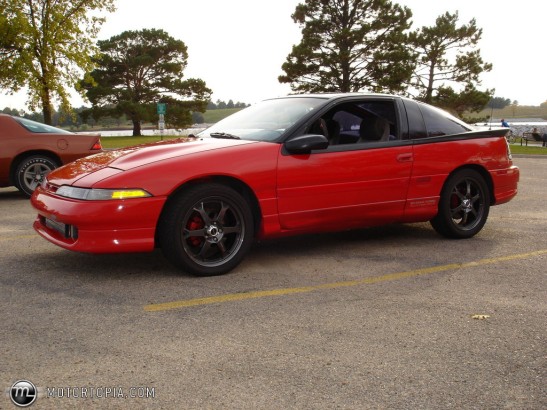1989-1994 Mitsubishi Eclipse GS-T/GSX

1991 Mitsubishi Eclipse GSX

Eclipse interior
The Mitsubishi Eclipse burst onto the scene in late 1988 as a 89 model. It was the first fruit of a collaboration with Chrysler called the Diamond Star Motor Company. Already producing the Galant at its Normal Illinois plant, the compact four passenger two door hatchback would be based on the Galant’s chassis. The car was available in five trim levels (Base,GS, GS DOHC, GS-T and GSX) with everything from a 1.8 L SOHC to 2.0 L DOHC turbocharged 4, all transversely mounted up front. The bulk of Eclipse sales came from the GS model, with its 135 hp normally aspirated engine. You can read more about this setup in a pervious entry about the 98-94 Eagle Talon ES. The top and most sought after versions were the GS-T (T for turbo) and GSX (X for all-wheel drive). Chrysler had its version also in the lower cost Laser and the more optioned Eagle Talon. In keeping with its more “upmarket” image, the Talon was not available with the lower cost 1.8 L until 1993, while the Eclipse maintained the full line of engine, powertrain and trim options .
The relatively affordable GSX opened up the all-wheel drive compact coupe segment to mainstream acceptance. Before it, one could choose from the expensive and rare All-Trac Toyota Celica or a few quirky looking Subarus. The performance of the GS-T and GSX really captured the imagination of the press, evenly divided over the straight forward rocket like speed of the GS-T with its lighter weight or the exceptional all-weather handling abilities of the heavier all-wheel drive GSX. At 195 hp (190) for cars equiped with the 4-speed automatic, the GS-T especially had one of the most favorable power to weight ratios of any car in its class as the 90’s dawned.
The looks of the Eclipse attracted much attention also, strangely managing to look better than anything Chrysler or Mitsubishi had come up with in the recent past. The interior, like all the other Diamond Star Coupes, was cramped for bigger people, but comfortable. The dashboard featured an angled design that ensured that all the controls could be reached in an arc. The hatchback design with a small fold down rear seat offered increased versatility if not a concession to the insurance companies.
The first generation Eclipse (1GA) was available in five trim levels (Base,GS, GS DOHC, GS-T and GSX) with everything from a 1.8 L SOHC to 2.0 L DOHC turbocharged 4, all transversely mounted up front. The bulk of Eclipse sales came from the GS model, with its 135 hp normally aspirated engine. The top and most sought after versions were the GS-T (T for turbo) and GSX (X for all-wheel drive). The 6 bolt engine design made the cars popular with tuners because the engine blocks could stand considerably more power than stock. Chrysler had its version also in the lower cost Laser and the more optioned Eagle Talon. In keeping with its more “upmarket” image, the Talon was not available with the lower cost 1.8 L until 1993. All Diamond Star cars from 1989-1991 featured pop-up headlights.
Mechanically, the Eclipse was packed with the latest technology. Much of its powertrain and suspension components came from the Gallant, which was designed with either front or all-wheel drive in mind from its inception. All Eclipses featured disc brakes all around. The GSX featured a limited-slip center differential. The GS-T and GSX both featured a fully independent suspension, while lesser models had a torsen beam rear with front McPherson struts. Two transmission options were available, the standard 5 speed manual or optional 4 speed automatic. Automatic cars had 5 hp less than the manual.
The performance of Eclipse GSX was usually at the top of any comparison test it was featured in (often bested by the more expensive Honda Prelude). The GS-T was also a press favorite, finishing in the top in tests against other front and sometimes rear wheel drive coupes like the Probe GT, and Mustang LX 5.0. In 1992 all the Diamond Star coupes received a redesigned front end now with exposed halogen lights and a new tailight assembly. The Eclipse featured its own ground effects package and spoiler, but still resembled the Talon (except for the body colored roof). The Eclipse was for a long time Mitsubishi’s most popular car, made more popular (new or used) after the event of the “Fast and the Furious” film which featured a second generation Eclipse. Sales of Chrysler’s versions of the car were slowly decreasing and by 1995, the first year of the second generation, the Plymouth Laser was discontinued. If you are fortunate enough to find one of these cars unspoiled by would be tuners, you will find that they are reliable and somewhat efficent (if well maintained) year-round transportation.

1994 Mitsubishi Eclipse GSX
